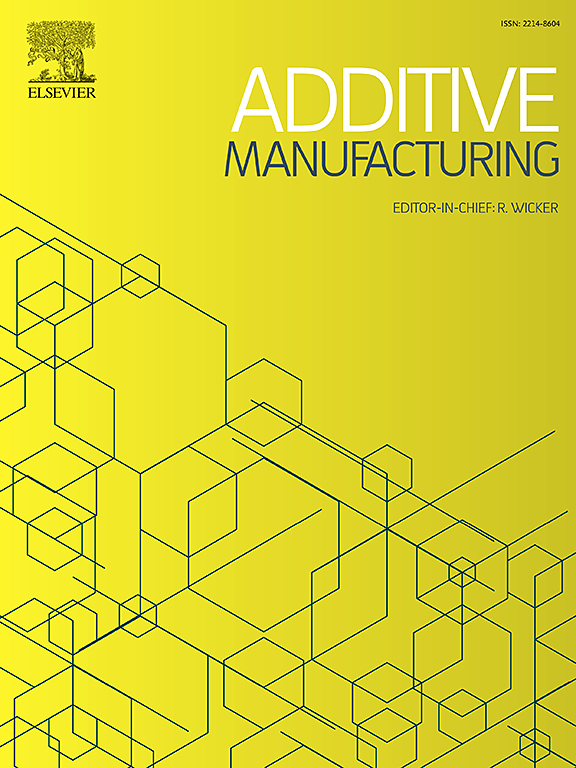静电力在微激光粉末床熔合中粉末扩散中的关键作用
IF 10.3
1区 工程技术
Q1 ENGINEERING, MANUFACTURING
引用次数: 0
摘要
微激光粉末床熔融(Micro - lpbf)是一种高精度的增材制造技术,通常使用小于20 μm的细粉末颗粒。然而,由于微lpbf中粉末颗粒尺寸小,团聚严重,导致粉末层质量差,堆积密度降低,表面粗糙度变差。这是至关重要的,因为粉末层的质量直接影响到打印件的质量。在本研究中,我们利用实验和数值方法研究了微lpbf中的粉末扩散机制。实验中使用了橡胶刮刀和金属刮刀,橡胶刮刀获得了更致密的粉末层,相对堆积密度为~ 40%,优于金属刮刀(~ 30%)。模拟和实验都证实了摩擦产生的静电力的存在和关键作用,这是我们所知的第一个报告。与金属刮板相比,具有更大功函数和更高表面能密度的橡胶刮板在粉末颗粒之间产生更强的静电力。因此,范德华力的吸引作用被排斥的静电力抵消,减轻了粉末的团聚,从而产生更致密的粉末层。另一方面,也发现更多的粉末颗粒粘附在橡胶刮板的底部,导致较不理想的粉末层,特别是当层厚度非常小的时候。本研究提供了新的科学认识,对根据粉体材料选择刮刀,通过调节粉体颗粒间的静电力达到高质量的粉体层具有实际指导意义。本文章由计算机程序翻译,如有差异,请以英文原文为准。
Critical role of electrostatic forces in powder spreading in micro laser powder bed fusion
Micro laser powder bed fusion (micro-LPBF) is a highly precise additive manufacturing technique typically utilizing fine powder particles smaller than 20 . However, the small size of powder particles in micro-LPBF results in serious agglomeration, leading to poor quality of the powder layer, characterized by reduced packing density and worsened surface roughness. This is crucial as the powder layer quality directly impacts the quality of as-printed parts. In this study, we leverage experimental and numerical approaches to investigate the powder spreading mechanisms in micro-LPBF. Both rubber and metal scrapers are used in the experiments, and the rubber scraper achieves a denser powder layer with the relative packing density of ∼ 40 %, outperforming the metal scraper (∼ 30 %). Both simulation and experiments confirm the existence and critical role of the electrostatic force originating from friction, which is the first report to the best of our knowledge. Compared to the metal scraper, the rubber scraper with a larger work function and a higher surface energy density produces stronger electrostatic forces between powder particles. Consequently, the attractive effects of van der Waals forces are counteracted by the repulsive electrostatic forces, alleviating the powder agglomeration and thus resulting in a denser powder layer. On the other hand, it is also found that more powder particles adhere to the bottom of the rubber scraper, leading to a less optimal powder layer, especially when the layer thickness is very small. This study has provided new scientific understanding and can offer practical guidance on selecting scrapers according to the powder materials to achieve high-quality powder layer by adjusting the electrostatic forces between powder particles.
求助全文
通过发布文献求助,成功后即可免费获取论文全文。
去求助
来源期刊

Additive manufacturing
Materials Science-General Materials Science
CiteScore
19.80
自引率
12.70%
发文量
648
审稿时长
35 days
期刊介绍:
Additive Manufacturing stands as a peer-reviewed journal dedicated to delivering high-quality research papers and reviews in the field of additive manufacturing, serving both academia and industry leaders. The journal's objective is to recognize the innovative essence of additive manufacturing and its diverse applications, providing a comprehensive overview of current developments and future prospects.
The transformative potential of additive manufacturing technologies in product design and manufacturing is poised to disrupt traditional approaches. In response to this paradigm shift, a distinctive and comprehensive publication outlet was essential. Additive Manufacturing fulfills this need, offering a platform for engineers, materials scientists, and practitioners across academia and various industries to document and share innovations in these evolving technologies.
 求助内容:
求助内容: 应助结果提醒方式:
应助结果提醒方式:


